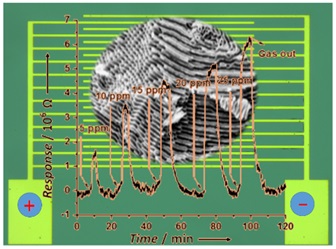A Micelle Fusion−Aggregation Assembly Approach to Mesoporous Carbon for Ultrasensitive Ammonia Sensing
Recently, Prof. Dongyuan Zhao of iChEM and coworkers reported a micelle fusion-aggregation assembly method to fabricate functional mesoporous carbons with highly ordered hexagonal mesostructure and unique buckled large mesopores by using poly(ethylene oxide)-block-polystyrene (PEO-b-PS) diblock copolymers as a template and resorcinol-based phenolic resin as a carbon precursor. These functional materials exhibit an excellent performance in sensing NH3 which is a typical pungent gas that can cause irritation to eyes, skins and respiratory tracts. Related result was published online in Journal of the American Chemical Society (DOI: 10.1021/jacs.6b07355).

Normally, mesoporous carbons are synthesized by using commercial Pluronic type amphiphilic triblock copolymers as templates through a co-assembly process of copolymers an polymerizable precursors (e.g. resol), followed with solidification of the resultant composites and finally selectively removing the templates. Prof. Zhao's group created a novel solvent evaporation induced micelle fusion-aggregation assembly approach, in which, they can selectively evaporate a good solvent THF lab-made PEO-b-PS copolymer templates from the basic THF/H2O solution containing resorcinol-based resols. By using such smart method, highly ordered mesoporous carbons with 2D hexagonal mesostructured and large cylindrical mesopores have successfully been synthesized. By simply varying the hydrophobic PS length of the template, the mesopore size of the obtained functional mesoporous carbons can be readily tunable from 26.2 to 36.3 nm, and their specific surface area and pore volume can be as high as 571 m2/g and 0.54 cm3/g, respectively. Another unique feature of the obtained mesoporous carbon materials is high density of active groups (-COOH). They demonstrated that these functional mesoporous carbon materials can be used as a promised material for fabrication of NH3 sensing devices working at a low temperature. It exhibits an excellent sensing performance with a fast response, ultralow limit of detection of 1 ppm, and excellent selectivity, opening up the opportunity for application in monitoring the concentrations of gaseous harmful gas substances in air.
This work was supported by Ministry of Science and Technology, NSFC, Shanghai Committee of Science and Technology, Ministry of Education, etc.
Paper link:http://pubs.acs.org/doi/abs/10.1021/jacs.6b07355





